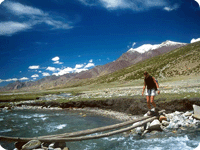
Ladakh, or La-Dags, the land of many passes, lies on the northern tip of India's frontiers with Pakistan and China. A vast expanse of wind-swept cold desert, Ladakh covers about sixty percent of Jammu & Kashmir's land area, but houses only a fraction of its population. Divided into the main regions of Leh and Kargil, this region has remained isolated from the rest of the world for a long time.
Entering 'Little Tibet' as Ladakh is commonly known, you get transported into a different age, when people travelled across high mountain passes and over swift-flowing rivers, kings ruled with a firm hand and on occasion, marauding armies swept in to carry away the wealth. Lying on the cross roads of the fabled Silk Route, Ladakh was a important halt for the caravans that made their way across the hostile Karakoram Ranges into Central Asia.
Ladakh's hostile mountainscape, the austere terrain around Leh (capital city of Ladakh), the green river valleys, winding roads straddling towering mountains, untouched wildernesses of the Zanskar valley and the unforgiving terrain of the Kargil region are all about unravelling nature at its starkest. At every bend of the road, every tiny hamlet across the river and remote monastery on the hillside, an intriguing picture unfolds before your eyes. Ladakh - a land, truly unparalleled in its majestic beauty.
Habitat
This mysterious land is criss-crossed by the four great mountain ranges of the Great Himalayas, the Zanskar, Ladakh and Karakoram. The Indus, Zanskar, Shingo and Shyok rivers, along with their tributaries and smaller streams, sustain life in this difficult terrain. The world's largest glaciers outside the poles are found in Ladakh.
Ladakh is one of the few unspoilt regions of India, where nature rules over man. Rivers run deep gorges into the brown mountains, while the forested areas are covered with willows and poplars. Sweet smelling junipers grow in abundance and are used in religious ceremonies. Pangong Tso, one of the largest salt water lakes in Asia, and Tso Moriri lake down to the east, are the natural habitat of several rare species of birds, including the bar-headed geese, Brahminy duck and black-necked crane. Animals include the ibex, red foxes, wolves, mouse hare, the Tibetan wild ass of kiang, the brong drong or wild yak, kyang or wild horse and nyan the large horned sheep. Amongst the rarest animals to be found in the region are the snow leopard, the musk deer, Tibetan gazelle and the chiru antelope that is sought for its shahtoosh wool.
Unspoilt by large-scale industrial activity or polluting vehicles, the environment of Ladakh is comparatively clean. However, increasing tourist traffic has taken its toll on the fragile ecosystem. Local efforts at keeping the water sources and mountains unpolluted have been initiated, most visibly in the main town of Leh.
Climate
The climate in Ladakh is one of extremes. Winter temperatures go down to 30 degree below zero in Leh and Kargil. The severest cold is experienced in the wind swept town of Drass, where the temperature dips to minus 60 degrees. Tap water freezes, the Zanskar becomes a sheet of ice over which nomadic tribes trudge across to the Indus valley. In summer with thawing comes the bright scorching sunlight. Temperatures at this time range between 20 degree and 38 degree Centigrade in different parts of Ladakh. With very little vegetation providing wind breaks or cover and so, totally exposed to the elements, Ladakh experiences high velocity dust storms and snow blizzards.